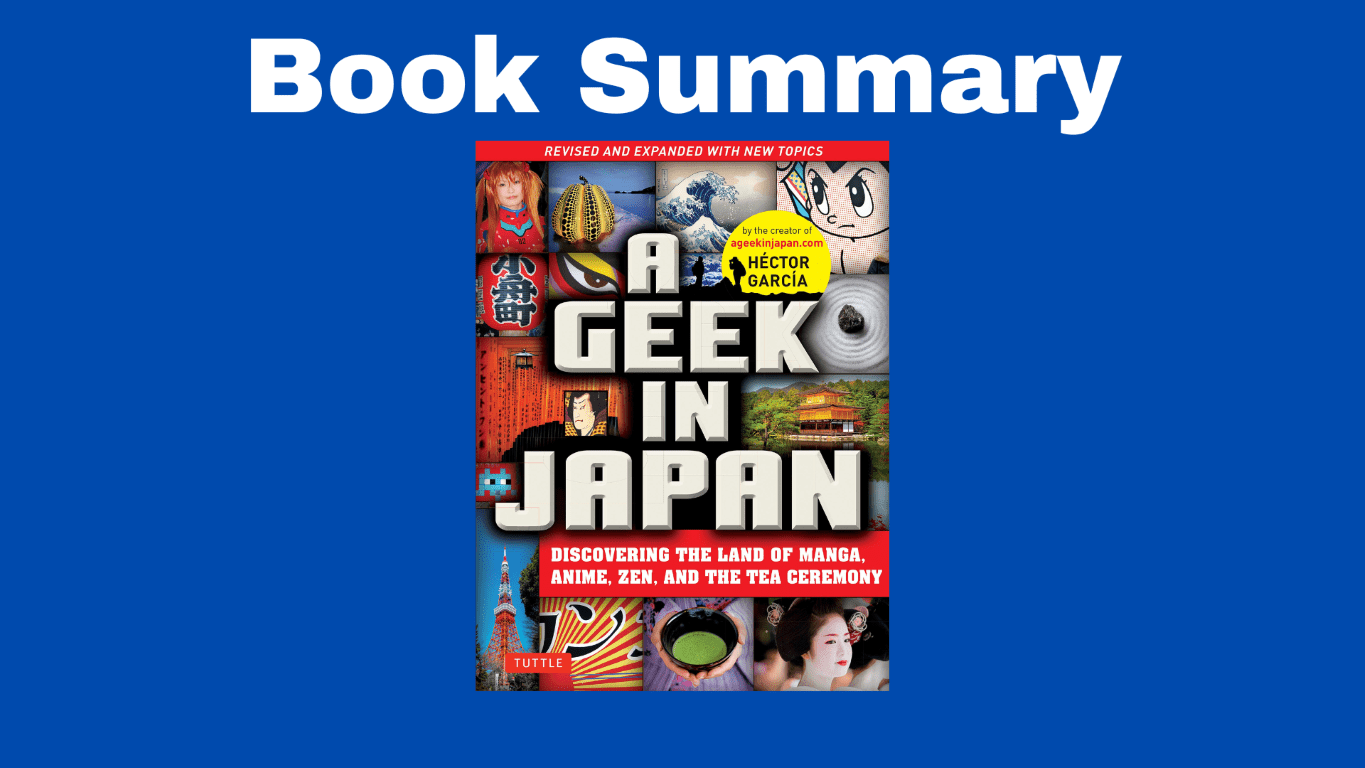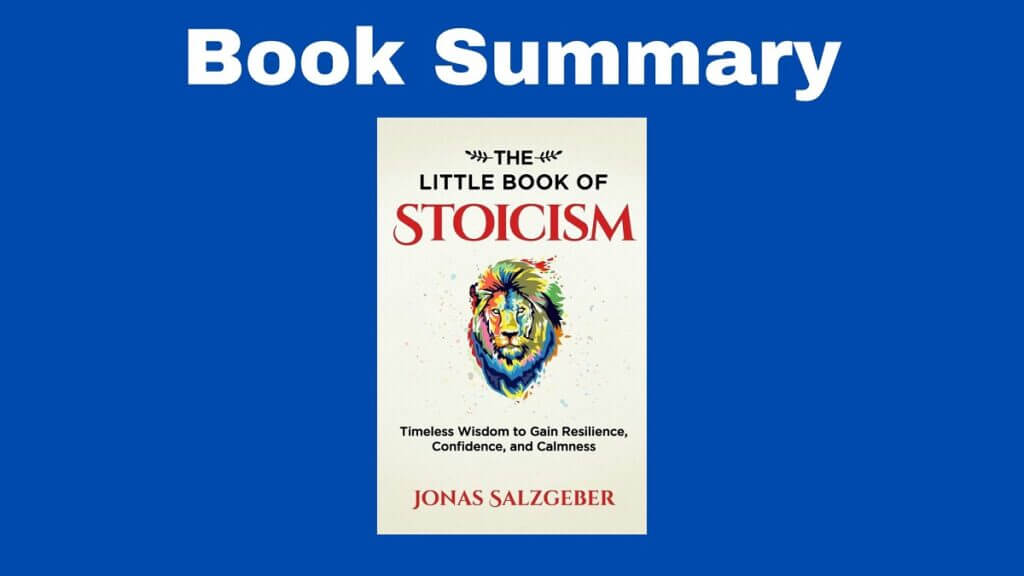The Book in Three Sentences
A Geek in Japan is a culture guide with personal essays and photographs. Some of the topics discussed include Japan’s language, social values, business, technology, arts, symbols, and more. There’s even a section dedicated to debunking myths and answering common questions about Japan.
A Geek in Japan Summary
The Japan Few People See
Hector Garcia was so fascinated with Japan that he created a blog called A Geek in Japan and he then turned ideas from the blog into a book. Japan seems foreign to the Western world. Japanese people don’t like standing out, yet their presence is everywhere, including in technology, minimalism, and Japanese cars.
Why is Japan Different?
- One of the reasons why Japan is different is because of the influence of China on the Japanese language, religion, and system of governance.
- Japan was closed to the outside world during the Edo period (1600 – 1867).
- Japan used to be imperialist, a period that ended after World War II. When it recovered, Japan became the second-largest economy.
The Initial Culture Shock
- The Japanese treat customers extremely well.
- Baseball and horse racing are important.
- Japanese like the game of go.
- Trains are important in day-to-day life and they are incredibly punctual.
Chapter 1: The Origins of Japanese Culture
An Extremely Brief History of Japan
According to a legend, Japan was the result of the love between Izanagi and Izasami. Their daughter was Amaterasu and emperors descend from her. In other words, the emperor is considered a god.
Japan’s first inhabitants lived 8000 years ago. The Japanese state started in the 8th century in Nara, a capital modeled after Chinese cities. Due to wars and conflict though, the emperor moved from Nara to Kyoto, which became Japan’s capital for the next 1000 years.
War continued and the leader of the Minamoto clan became a shogun, establishing his headquarters in Tokyo. The shogun controlled Japan and the emperor lost most of his power. At that time, China introduced Zen Buddhism to Japan. The samurai emerged too.
The battle of Sekigahara took place in the year 1600. The Tokugawas started their reign. Edo (current Tokyo) became the new capital. The Tokugawas prohibited foreigners to visit Japan. Any foreigners found were punished by death. Since the country was cut off from the rest of the world, Japanese people fell in love with their own country. Nationalism grew rampant, people worked endlessly, and to them, Japan was the center of the world.
This period came to an end in July 1853, when America proposed a trade between both nations. Both the shogun and emperor refused, but their military power was weak in comparison to the Americans’. The shogun signed a treaty but lost all the respect of his people for disobeying the words of the emperor. The shogun resigned. Edo became Tokyo and Japan officially entered the modern world. While the rest of the world had seen the industrial revolution, Japan was still using donkeys and horses. In just a few decades (around 70 years), Japan challenged the United States in World War II in terms of power and technology.
The intricacies of the Japanese Language
130 million people speak Japanese. Although Japanese and Chinese look somewhat similar, they aren’t in the slightest. Japanese has Kanji, hiragana, and katakana, though the last two developed later. Kanji characters can have one or several meanings and pronunciations. There are more than 40,000 kanji. The hiragana syllabary, on the other hand, has 46 characters and they represent the 46 consonant and vowel combinations in spoken Japanese. Finally, the Katakana syllabary is used to write words of foreign origin.
Bushido is the code of the samurai. It means “the way of the warrior” and was influenced by Zen Buddhism and Confucianism. Zen wants enlightenment through the liberation of the mind. To achieve this, body and spirit should be one. Samurai were calm and patient. They trained that way to face the hardships of battle. Confucianism states that relationships among human beings are the basis of society. Certain values, such as loyalty to their lord, justice, and honor are paramount. Though samurai are long gone, the concept of loyalty is extremely important in Japan. Bushido penetrated every aspect of society, even martial arts. Judo is the way of flexibility, Aikido is the way of the energy and Karatedo is the way of the empty hand.
Despite what some think, Geishas are artists. They perform in private for men, but they aren’t prostitutes.
Religion and Philosophy
Buddhism came from China and Korea as early as the 6th century. The idea behind Buddhism is to achieve enlightenment through sacrifice and indifference towards material possessions. There is an ancient tradition in which monks travel with as few possessions as possible. They rely on people’s donations to survive.
Confucianism is all about respect and loyalty to the system and helping others.
Shinto is all about seeking happiness not in the afterlife, but in this life. Nature is sacred.
Stealing something from someone is the same as stealing their spirit. This explained why thefts in Japan don’t happen.
Chapter 2: The Traditional Arts and Disciplines
Chado: this is known as the Tea Ceremony. Tea is one of the most popular drinks in Japan. The tea ceremony originated in Zen Buddhism. Matcha is a variety of green tea and originated in Japan.
Kabuki Theater: it began in the Edo period. All actors are men and their faces are painted white.
Martial arts: the function of martial arts was to train for real battles. Japanese martial arts include judo, aikido, kendo, and sumo.
Chapter 3: The Unique Japanese Character
Modesty and humility are important values in Japan.
The Ie system creates a hierarchy within the family. Women’s role was to have children. Confucianism worsened this even more. Women were told to stay at home and men outside. Nowadays, men work, have dinner with coworkers, and go home to sleep. They have family time on the weekends.
The Japanese apologize for everything all the time. There are many expressions for apologizing.
Japan is one of the most advanced countries with the lowest immigration rate. They believe in harmony and avoid conflict at all costs. Being an immigrant is seen as a threat to harmony and that’s why to this day, Japan is considered a “closed country”.
Chapter 4: Curiosities and Symbols
Tanuki is a raccoon-like animal that brings good fortune. He usually has big testicles, representing good luck. He became in the west because there’s a Tanuki suit in Super Mario Bros. 3.
The lucky cat is supposed to make a business prosper. The left paw attracts customers. The right paw attracts money.
Sakura is the name of the cherry tree and the flower. The blooming of the Sakura in April is a nationwide event.
Face masks in Japan are used to avoid contagion when you have a cold. Its main purpose is for pollen allergies. To meet the demand for wood after World War II, Cedar trees were planted. When they are 30-40 years old, the trees generate pollen.
The Japanese take hot baths together as a family in order to communicate.
Pachinkos are pinball-like machines that give you money if you win. Gambling is illegal in Japan, but a legal loophole allows Pachinko to exist and since this is the closest thing to gambling Japanese people have, it’s extremely popular.
The Manji symbol is a good luck charm that repels evil. Although people associate it with the Nazi swastikas, the symbol represents good luck and prosperity.
Women cover their mouths when they laugh because this was considered indecent. In the Nara period, married women blackened their teeth which made them uncomfortable. Laughing shamelessly is bad manners.
Chapter 5: The Japanese at work
Kaizen means change for the better and it’s an idea to be in constant improvement. The term is usually used in business. A company that applied this concept is Toyota and it’s said that it has the best production system in the world. The Toyota production system corrects faults, overproduction, and waiting time.
Hierarchy in a Japanese company:
- Sacho: the president
- Bucho: the heads of each department
- Kacho: the chiefs of each subsection
- Kakaricho: supervisors
- Kaishain: low-level employees
Chapter 6: Japanese Society and Daily Life
Japan is a country with one of the lowest crime rates in the world because selling firearms is restricted, there are severe penalties for committing a crime, and there’s little to no drug trafficking.
The family has breakfast together (miso soup, rice, fish). Parents go to work and children go to school. Children have lunch at school and help clean. The mother gets home early and has dinner with the children. The father works late and goes out with coworkers.
The life expectancy for Japanese men is 80 and for Japanese women 85. Their key to longevity seems to be the Japanese diet which is based on little fat, a lot of fish and seaweed, and green tea. On top of that, the Japanese don’t overeat.
Trains in Japan are people’s second home. Since most commute a lot, they rely on trains and that’s why they’re so punctual. People read, answer emails, play games, or sleep on trains.
Urban legends:
- Everything is expensive in Japan. The three most expensive things in Japan are transport, housing, and education. Other than that, prices are very similar to other countries.
- Everybody reads manga.
- They all play games.
- Everything is extremely clean.
- Everybody speaks English.
Why do the Japanese commit suicide?
One of the main beliefs behind the Shinto religion is that you always have to do the right thing. Additionally, there’s a lot of social pressure to perform well in both work and school. Finally, the samurai committed suicide which was an honorable action.
Chapter 7: Japan Today
Otaku are obsessed with their hobbies, not just manga and anime.
Yakuza gangs started in the Edo period, they expelled the samurai and formed gangs. They controlled prostitution, gambling, and drugs.
There are many subcultures and urban tribes, including lolitas and people who role-play.
Chapter 8: The World of Manga and Anime
Manga became popular with Dragon Ball, Doraemon, and Sailor Moon. Anime became popular with Akira, Ghost in the Shell, and Studio Ghibli films.
The origins of Manga
Manga started in the 12th century in the form of scrolls called Choju-Giga. A new technique allowed to reproduce these scrolls. Hokusai manga came out in 1814 using this new technique. It wasn’t until Osamu Tezuka, now known as the father of manga, that the medium really became massive. Tezuka was inspired by Disney’s animation and he combines western animation with Japanese art. His first work came out in 1947 and sold 400,000 copies.
Manga’s golden age started when shojo and shonen became more defined genres. Shonen manga includes popular titles, such as Bleach, Naruto, Dragon Ball, and Fullmetal Alchemist, among many others. Popular shojo manga include Sailor Moon and Cardcaptor Sakura.
Chapter 9: Modern Japanese Music
Enka are ballads and the genre’s usually known as Japan’s national music. It’s melodramatic, sad, and nostalgic. Also, quite repetitive in structure. People call Misora Hibari the music queen of Enka.
Music in video games is also incredibly popular both inside and outside of Japan. Some of the most popular composers include Koji Kondo, Nobuo Uematsu, and Utada Hikaru.
The Japanese are famous for karaoke, a practice that became more popular with the arrival of CDs and the Walkman.
Chapter 10: Movies and Television
In the 50s, Japanese movies became extremely influential thanks to the work of Akira Kurosawa, one of the best movie directors of all time. In the 60s and 70s, anime arrived on TV. During the 80s and 90s animated dominated Japanese television, thanks to shows like Dragon Ball, Evangelion, One Piece, Naruto, and Studio Ghibli films.
One of the most popular characters in Japanese media is Godzilla which came out in 1954. People also remember Gamera, a monster created by a competing studio that wanted to capitalize on Godzilla’s success.
Chapter 11: Visiting Tokyo
This chapter focuses on some areas of interest in Tokyo itself, as well as other cities in the Greater Tokyo area. Since the book was written in 2010, some descriptions don’t really apply to real-life places anymore and I decided not to include them.
Chapter 12: Travelling Around Japan
General Advice for Travellers
- Don’t worry: Japan has everything you might need
- Choose the right time: the author suggests that readers to travel to Japan in spring or fall. That’s between March and June.
- Buying a plane ticket: do it between two and three months before actually visiting the country.
- Japan Rail Pass: since transport is one of the most expensive things in Japan, foreigners can buy a season ticket called the Japan Rail Pass. You can only buy this pass outside of Japan.
- Accommodations: research accommodations before traveling. Some of them include youth hostels, business hotels, Ryokan (which are traditional Japanese-style hotels), and more exotic options, such as love hotels and capsule hotels.
- Electrical power: Japan’s electric power system is at 110V/50Hz, similar to the one in the US. People from countries that have a different electric power system can use a cheap converter to use and charge devices.
- Mobile phones and the internet: you can use roaming depending on the company you use in your own country. You can also rent cards to use with your Wi-Fi-enabled devices. There are also free hotspots in some parts of large cities.
- Japanese manners: Japanese people are extremely polite, so learn some basic expressions to interact with them.
- Shopping in Japan: you can’t take food products overseas and not all devices are cheaper in Japan than in the US or Europe.
- Calculating expenses: to calculate expenses take into account accommodations, transportation, food, admission to different places, and gifts you buy.
- Credit cards and money: as a general rule, try to change money as soon as you arrive in Japan. Some ATMs don’t work with certain cards, so always have cash as an alternative.
- Planning your trip: plan your trip according to the number of days you’ll be spending in Japan.
- How to get around by train: there are several websites, online services, and apps to guide you.
Essential places to visit:
- Matsumoto
- Nikko
- Kamakura
- Nara
- Hakone
- Hiroshima
- Kyoto




